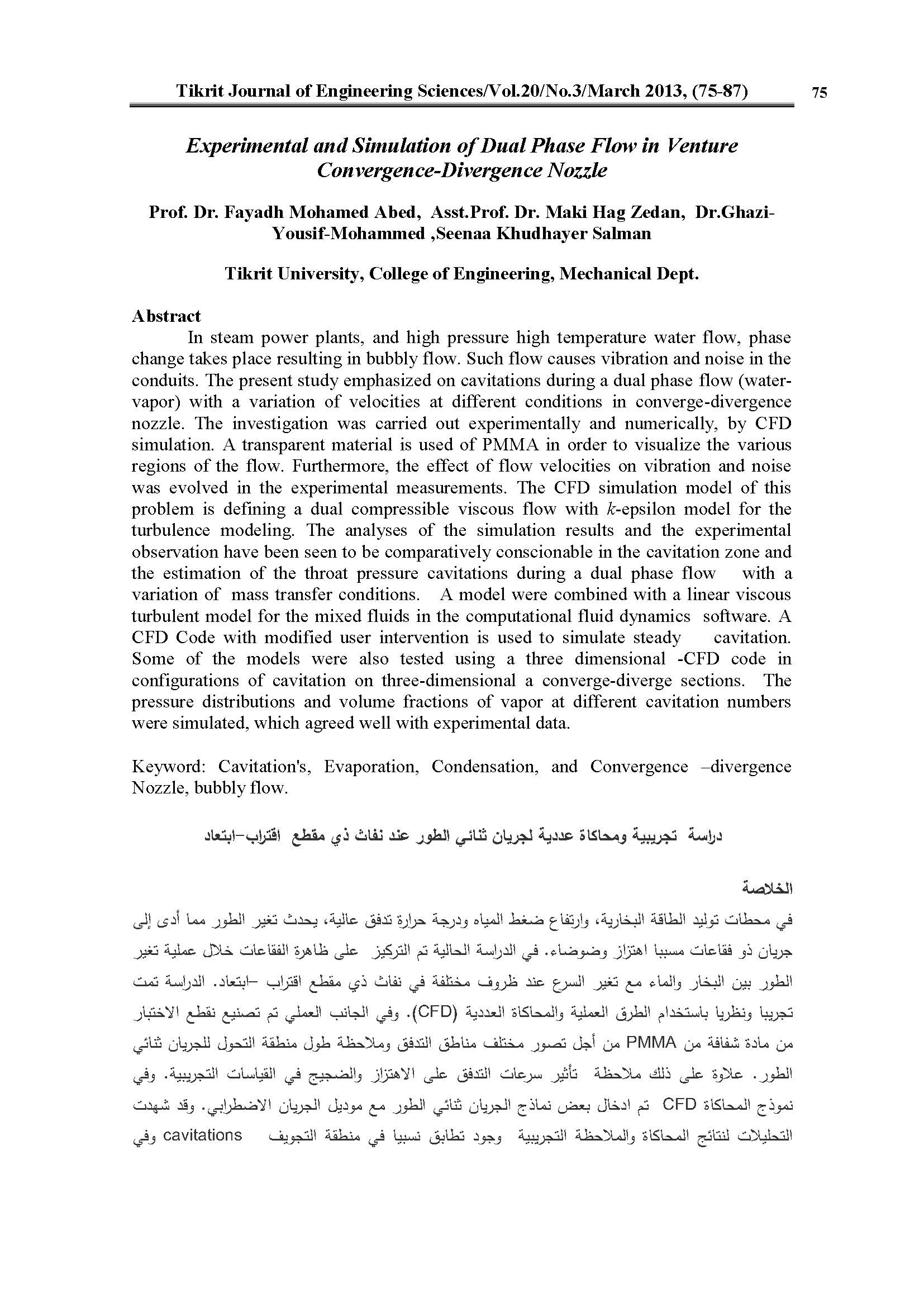Experimental and Simulation of Dual Phase Flow in Venture Convergence-Divergence Nozzle
Main Article Content
Abstract
In steam power plants, and high pressure high temperature water flow, phase change takes place resulting in bubbly flow. Such flow causes vibration and noise in the conduits. The present study emphasized on cavitations during a dual phase flow (water-vapor) with a variation of velocities at different conditions in converge-divergence nozzle. The investigation was carried out experimentally and numerically, by CFD simulation. A transparent material is used of PMMA in order to visualize the various regions of the flow. Furthermore, the effect of flow velocities on vibration and noise was evolved in the experimental measurements. The CFD simulation model of this problem is defining a dual compressible viscous flow with k-epsilon model for the turbulence modeling. The analyses of the simulation results and the experimental observation have been seen to be comparatively conscionable in the cavitation zone and the estimation of the throat pressure cavitations during a dual phase flow with a variation of mass transfer conditions. A model were combined with a linear viscous turbulent model for the mixed fluids in the computational fluid dynamics software. A CFD Code with modified user intervention is used to simulate steady cavitation. Some of the models were also tested using a three dimensional CFD code in configurations of cavitation on three-dimensional a converge-diverge sections. The pressure distributions and volume fractions of vapor at different cavitation numbers were simulated, which agreed well with experimental data.
Metrics
Article Details

This work is licensed under a Creative Commons Attribution 4.0 International License.
THIS IS AN OPEN ACCESS ARTICLE UNDER THE CC BY LICENSE http://creativecommons.org/licenses/by/4.0/
Plaudit
References
Batchelor, G.K., 1967, An Introduction to Fluid Dynamics, Cambridge University Press, New York.
Versteeg, H. K., Malalasekera W., “An Introduction to Computational Fluid Dynamics – The Finite Volume Method”, Longman Group Ltd, 1995
Kubota A., Kato H., Yamaguchi H.: A New Modeling of Cavitating Flows: A Numerical Study of Unsteady Cavitation on a Hydrofoil Section. J. Fluid Mech. 1992 DOI: https://doi.org/10.1017/S002211209200003X
Senocak I., Shyy W.: Evaluation of cavitation models for Navier-Stokes computations, Proceeding of FEDSM 02, ASME fluid engineering division summer meeting, Montreal, Canada, 2002 DOI: https://doi.org/10.1115/FEDSM2002-31011
Lee et al., 1992; Kinnas and Fine, 1993, and Euler/Navier‐Stokes equation‐based models (Chen and Heister, 1994; Deshpande et al., 1997).
Delannoy and J. L. Kueny, “Cavity flow predictions based on the Euler equations,” in Proceedings of the ASME Cavitation and Multi-Phase Flow Forum, vol. 109, pp. 153–158, Portland, Ore, USA, June 1990.
C. L. Merkle, J. Z. Feng, and P. E. Buelow, “Computational modeling of the dynamics of sheet cavitation,” in Proceedings of the 3rd International Symposium on Cavitation (CAV ’98), pp. 307–311, Grenoble, France, April 1998.
K. Singhal, M. M. Athavale, H. Li, and Y. Jiang, “Mathematical basis and validation of the full cavitation model,” Journal of Fluids Engineering, vol. 124, no. 3, pp. 617- 624, 2002. DOI: https://doi.org/10.1115/1.1486223
R. F. Kunz, D. A. Boger, D. R. Stineberg, T. S. Chyczewski, J.W. Lindau, and T. R. Govindan, “Multi-phase CFD analysis of natural and ventilated cavitation about submerged bodies,” in Proceedings of the 3rd ASME/JSME Joint Fluids Engineering Conference (FEDSM ’99), p. 1, San Francisco, Calif, USA, July 1999
Y. Shen and P. Dimotakis, “The influence of surface cavitation on hydrodynamic forces,” in Proceedings of the 22nd American Towing Tank Conference (ATTC’89), pp. 44–53, St. John’s, Canada, August 1989.
B. Stutz and J.-L. Reboud, “Two-phase flow structure of sheet cavitation,” Physics of Fluids, vol. 9, no. 12, pp. 3678–3686, 1997. DOI: https://doi.org/10.1063/1.869505
J.-B. Leroux, O. Coutier-Delgosha, and J. A. Astolfi, “A joint experimental and numerical study of mechanisms associated to instability of partial cavitation on two- dimensional hydrofoil,” Physics of Fluids, vol. 17, no. 5, Article ID 052101, 20 pages, 2005. DOI: https://doi.org/10.1063/1.1865692
J.L.Reboud and B. Stutz, “Développement d’un modèle diphasique à deux fluides, analyse expérimentale de poches ventilées,” réf.RT-LT-211708-01 CREMHyG- 03.
R. F. Kunz, D. A. Boger, D. R. Stinebring, et al., “A preconditioned Navier-Stokes method for two-phase flows with application to cavitation prediction,” Computers & Fluids, vol.29, no. 8, pp. 849–875, 2000. DOI: https://doi.org/10.1016/S0045-7930(99)00039-0
Coutier Delgosh, O., Andre Astolfi, J., “Numerical Prediction of the Cavitating Flow on a Two Dimensional Symmetrical Hydrofoil with a Single Fluid Model”, Fifth International Symposium on
Cavitation, Osaka, Japan (2003),





